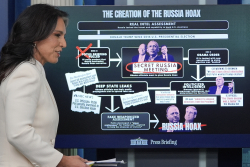Despite its ambitious design, the Typhon frigate program faced significant technical, financial, and bureaucratic challenges that ultimately led to its cancellation.
America’s Cold War with the Soviet Union not only shaped the development of modern America’s institutions, but also defined the world order as we understand it today. A major area directly impacted by that decades-long ideological coonflict between Moscow and Washington was in the arena of designing weapons, warplanes, and warships. While several innovative platforms were unveiled back in those days, there were many more concepts that either never made it to production or failed to perform as expected.
One ambitious but ultimately unrealized American project was the development of the Typhon frigate, a nuclear-powered guided-missile frigate (DLGN) envisioned as a revolutionary platform to counter Soviet naval advancements in the 1950s.
Why Did America Want a Nuclear-Powered Frigate?
In 1957, the Chief of Naval Operations, US Navy Admiral Arleigh Burke, raised alarms about the Soviet Union’s fleet of over 300 modern submarines, which posed a significant danger to NATO’s maritime supply lines across the Atlantic. To make matters worse, the Soviet Navy was developing sophisticated anti-ship missiles capable of being launched from aircraft and surface vessels, which could overwhelm traditional naval defenses.
At the time, the US Navy’s existing surface combatants were primarily World War II-era destroyers and early Cold War frigates that were rapidly becoming obsolete due to their limited speed, outdated sensors, and inadequate weaponry for countering these threats. Accordingly, the Navy initiated the Typhon program in May 1957, aiming to develop a next-generation air-and-missile defense system that would replace the existing Talor, Terrier, and Tartar (3-T) surface-to-air missile systems.
The Typhon system was envisioned as a comprehensive solution to the Soviet submarine and missile challenges, integrating advanced long-range (SAM-N-8 Typhon LR) and medium-range (SAM-N-9 Typhon MR) missiles with a revolutionary phased-array radar, the AN/SPG-59. This system was designed to counter saturation air attacks and operate effectively in environments with heavy electronic jamming.
The Navy proposed mounting this system on a new class of nuclear-powered frigates, designated DLGNs, which would serve as versatile, high-endurance escorts for carrier strike groups and convoys.
The Typhon-Class Frigates Were Floating Radars with Guns
The Typhon-class frigate was conceptualized as a large nuclear-powered warship with a displacement of 10,000-to-12,000 tons—making it significantly larger than contemporary frigates, like the Knox or Perry classes. Per its initial design, it was to be powered by two D2G nuclear reactors, providing a top speed of around 30 knots (35 miles per hour) and virtually unlimited range.
American naval planners intended to arm the Typhon-class with one long-range Typhon missile launcher forward—with 60 missiles, including ASROC anti-submarine rockets—and two medium-range launchers aft, with 40 missiles each. Additionally, the design called for two five-inch/54-caliber gun mounts for surface engagements and limited shore bombardment. The crew was estimated at 743, reflecting the complexity of operating the nuclear propulsion system and advanced electronics.
The centerpiece of the Typhon Frigate was its AN/SPG-59 radar, a fixed phased-array system that combined search, fire control, missile guidance, and target homing functions. Unlike traditional rotating radars, the SPG-59 scanned electronically, reducing reaction times and enhancing the ship’s ability to track multiple targets simultaneously. This radar was intended to enable the Typhon missiles to engage a wide range of threats, from high-altitude bombers to low-flying anti-ship missiles, and even provide limited anti-missile defense. Indeed, the AN/SPG-59 was a precursor to the far more successful, modern Aegis combat system.
Why the Navy Sank the Typhon Program
Despite its ambitious design, the Typhon frigate program faced significant technical, financial, and bureaucratic challenges that ultimately led to its cancellation. The AN/SPG-59 radar, the heart of the Typhon system, proved extraordinarily difficult to develop. Its complex electronics and cooling requirements pushed the limits of 1950s and early 1960s technology, resulting in delays and cost overruns. Testing aboard the USS Norton Sound from 1962 also revealed persistent issues with the radar’s reliability and performance, undermining confidence in the system’s readiness.
The Typhon class was also prohibitively expensive. The high cost of nuclear propulsion, already a point of contention with ships like the USS Bainbridge (DLGN-25), made the construction of an entire class of Typhon Frigates a questionable investment. Each ship was estimated to cost significantly more than contemporary destroyers or frigates, and the Navy struggled to justify the expense in the face of competing priorities such as those of aircraft carriers and submarines. Under the leadership of Secretary of Defense Robert McNamara, the Pentagon was notably skeptical of the program—especially given the Navy’s existing 3-T missile systems, which, while less advanced, were proven and operational.
Bureaucratic resistance played a decisive role, too. The Navy’s leadership was divided over the merits of nuclear propulsion for surface combatants. Interestingly, the Soviets would go on to load up their massive Kirov-class battlecruisers with nuclear power not long after the Typhon program fell through. Ultimately, the US Navy’s admirals were divided; some supported the Typhon as a forward-looking solution, while others argued that conventionally-powered ships with upgraded 3-T systems could achieve similar results at lower costs.
But whether or not the program would have effectively addressed the Soviet threat will never be known, as it was ultimately canceled in November 1962 at McNamara’s request.
What Can the Pentagon Learn from the Typhon Debacle?
Even today, struggles that defined the Typhon’s development dominate the development of similarly advanced systems. The supporters of the Typhon-class hoped to leapfrog existing technology. Yet as is so often the case, they failed to understand the true extent of the technical and financial hurdles of developing such a radically new system. The Navy’s experience with Typhon underscored the importance of incremental improvements and rigorous testing, lessons that shaped subsequent shipbuilding programs.
By canceling the Typhon-class frigate, the Kennedy administration was signaling a broader strategic shift toward more cost-effective, versatile platforms, as exemplified by the mass-produced Knox and Perry-class frigates, which prioritized anti-submarine warfare and affordability over the high-end capabilities of the proposed Typhon-class. Ultimately, the Navy survived without the Typhon—and would go on to defeat the Soviets three decades thereafter.
In other words, the lessons of the Typhon-class frigate development disaster remain relevant today. Back then, there were leaders in Washington who understood how to say “no” to the US military’s fixation on expensive platforms while maintaining war-winning capabilities. Today, with a $1 trillion defense budget in the offing, can we say the same?
About the Author: Brandon J. Weichert
Brandon J. Weichert, a Senior National Security Editor at The National Interest as well as a contributor at Popular Mechanics, who consults regularly with various government institutions and private organizations on geopolitical issues. Weichert’s writings have appeared in multiple publications, including the Washington Times, National Review, The American Spectator, MSN, the Asia Times, and countless others. His books include Winning Space: How America Remains a Superpower, Biohacked: China’s Race to Control Life, and The Shadow War: Iran’s Quest for Supremacy. His newest book, A Disaster of Our Own Making: How the West Lost Ukraine is available for purchase wherever books are sold. He can be followed via Twitter @WeTheBrandon.
Image: Wikimedia Commons.


















